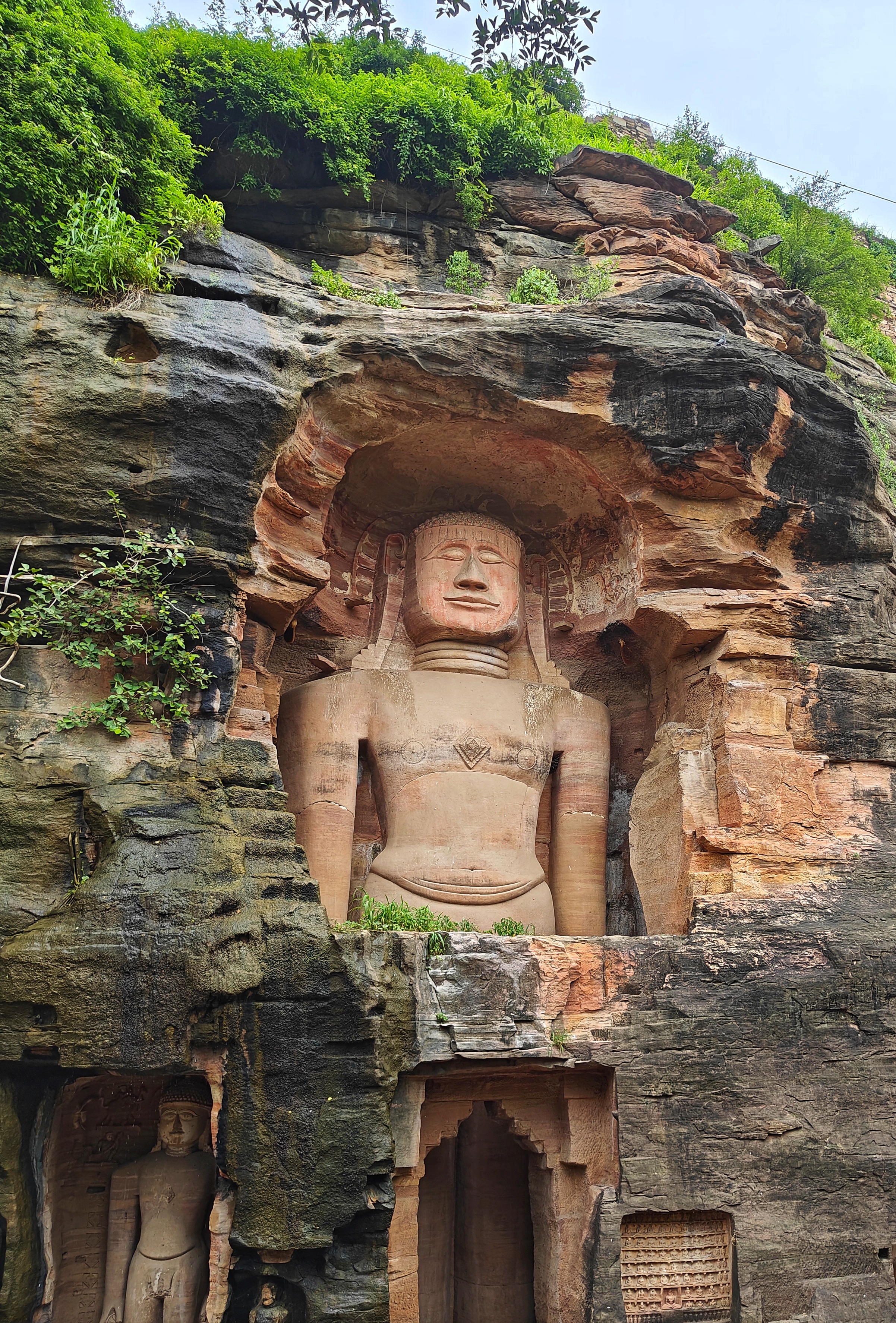Raighu on:
[Wikipedia]
[Google]
[Amazon]
 Raidhu (
Raidhu (
 Raidhu (
Raidhu (IAST
The International Alphabet of Sanskrit Transliteration (IAST) is a transliteration scheme that allows the lossless romanisation of Brahmic family, Indic scripts as employed by Sanskrit and related Indic languages. It is based on a scheme that ...
: Raidhū; 1393–1489) was an Apabhramsha poet from Gwalior
Gwalior (Hindi: , ) is a major city in the central Indian state of Madhya Pradesh; It is known as the Music City of India having oldest Gwalior gharana, musical gharana in existence. It is a major sports, cultural, industrial, and political c ...
, and an important figure in the Digambara
''Digambara'' (; "sky-clad") is one of the two major Jain schools and branches, schools of Jainism, the other being ''Śvetāmbara'' (white-clad). The Sanskrit word ''Digambara'' means "sky-clad", referring to their traditional monastic pract ...
Jain community. He supervised the pratishtha consecration ceremony of many—perhaps most—of the Jain idols carved on the hill side in the Gwalior Fort during the rule of Tomara rulers Dungarasimha and Kirtisimha.
Biography
Raidhu was born in the Padmavati Purval Jain community, as he himself acknowledged. His birthplace is uncertain, but he appears to have spent most of his life in or around Gwalior. He was a lay disciple of the Jain leader Bramha Shripal, who was a disciple of Bhattaraka Yashahkiriti of Kashtha Sangha. Raidhu was an important figure in the Gwalior court, where he stayed at the invitation of the Tomara king Dungarasimha. He was also a close associate of the Digambara ascetics ( Bhattarakas) who were influential in the Tomara court. Besides, Raidhu was patronized by several wealthy Jain merchants. Raidhu played a central role in connecting these different groups together: he authored religious books for the wealthy merchants, and encouraged them to donate money towards religious causes. Raidhu's powerful and wealthy sponsors helped disseminate his literary works, some of which are lavishly illustrated (e.g. ''Jasodharacariu''). These patrons included Kamalasimha, Yashahkirti, Khelha Brahmachari, Sanghadhipati Nemadasa and Asapati. Kamalasimha started the development of Gwalior as a Jain holy place, with support from the Tomara rulers Dungarasimha and Kirtisimha. The Digambara monk Yashahkirti and Khelha Brahmachari encouraged Raidhu to write ''Sammaijiṇacariu'', a biography ofMahavira
Mahavira (Devanagari: महावीर, ), also known as Vardhamana (Devanagari: वर्धमान, ), was the 24th ''Tirthankara'' (Supreme Preacher and Ford Maker) of Jainism. Although the dates and most historical details of his lif ...
. Khelha also commissioned the colossal image of Chandraprabha. Sanghadhipati Nemadasa was a patron of Raidhu's poem ''Puṇṇāsavakahākosa'', and also built a Jain shrine on his recommendation. Asapati was a minister of the Tomara king Dungarasimha.
Jain images
Raidhu was also responsible for consecrating many of the Jain rock carvings inside the fort, as attested by multiple inscriptions. These include the two colossal images ofAdinatha
Rishabhanatha (Devanagari: ऋषभनाथ), also Rishabhadeva (Devanagari: ऋषभदेव, ), Rishabha (Devanagari: ऋषभ, ) or Ikshvaku (Devanagari: इक्ष्वाकु, ''Ikṣvāku''), is the first (Supreme preacher) ...
(57 feet) and Chandraprabha
Chandraprabha () or Chandranatha is the eighth Tirthankara of of Jainism in the present age (). According to traditional accounts, he was born to King Mahasena and Queen Lakshmana Devi at Chandrapuri to the Ikshvaku dynasty. According to Jain ...
. Medieval Jain texts state that certain sacred mountains covered with images of Jinas would survive the destruction of the world. Raidhu's poems often mention the end times, and several near-contemporary poets also allude to the end times amid the Muslim conquests The Muslim conquests, Muslim invasions, Islamic conquests, including Arab conquests, Arab Islamic conquests, also Iranian Muslim conquests, Turkic Muslim conquests etc.
*Early Muslim conquests
** Ridda Wars
**Muslim conquest of Persia
*** Muslim co ...
. Therefore, it appears that the colossal Jain images were intended to ensure the survival of Gopalagiri (the Gwalior fort hill) in the end times.
Literary works
Raidhu composed several poems in Apabhramsha, many of which have survived. He composed many of these poems while living in the Jain temples of Gopalagiri. Rajaram Jain translated Raidhu's poems intoHindi
Modern Standard Hindi (, ), commonly referred to as Hindi, is the Standard language, standardised variety of the Hindustani language written in the Devanagari script. It is an official language of India, official language of the Government ...
language.
Raidhu's known works include:
* ''Anathmi Kaha''
* ''Appa Samboha Kavva'' ("Addressing myself")
* ''Balahadda Chariu'', written at the request of Agrawal Sahu Harsi.
* ''Bhadrabāhucariu''
** An account of Bhadrabahu
* ''Dashalakshana Jayamala''
* ''Dhanakumar Chariu''
* ''Jasodhara-Chariu''
* ''Jivandhar Chariu''
* ''Mesehar Chariu''
* ''Puṇṇāsavakahākosa'' (''Punnasava-kahakosa'')
** Composed at the request of Sanghadhipati Nemadasa
* ''Ritthanemi Chariu''
* ''Sammaijiṇacariu'' or ''Sammai Jinachariu''
** A biography of Mahavira
Mahavira (Devanagari: महावीर, ), also known as Vardhamana (Devanagari: वर्धमान, ), was the 24th ''Tirthankara'' (Supreme Preacher and Ford Maker) of Jainism. Although the dates and most historical details of his lif ...
, written on the request of Khelha Brahmachari, the son of Agrawal Sahu Tosau of Hisar. The book also gives a history of the family of Sahu Tosau since the time of Feroze Shah.
* ''Sammat Gunanihana''
** written on the request of Goel Agrawal Kamal Singh in sam 1492.
* ''Savaya Chariu''
** Written at the request of Golalare Sandhadhip Kusharaj
* ''Shodhashakarana Jayamala''
* ''Siddhantartha Sar''
* ''Siripal Chariu''
* ''Sukaushal Chariu''
* ''Vrattasar''
Some of his texts are still being discovered in Jain libraries. A Raidhu Award, named after him, of Rs. 21,000 is given every year by the Shyamlal Shastri Trust in Firozabad, Uttar Pradesh.
See also
*Jain literature
Jain literature () refers to the literature of the Jain religion. It is a vast and ancient literary tradition, which was initially transmitted orally. The oldest surviving material is contained in the canonical ''Jain Agamas'', which are wri ...
* History of the Hindi language
References
Bibliography
* Prof. Rajaram Jain {{authority control 14th-century Indian poets Indian Jain poets 14th-century Indian Jains 15th-century Indian Jains 15th-century Indian poets Poets from Madhya Pradesh